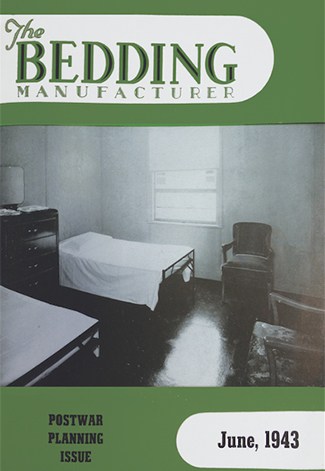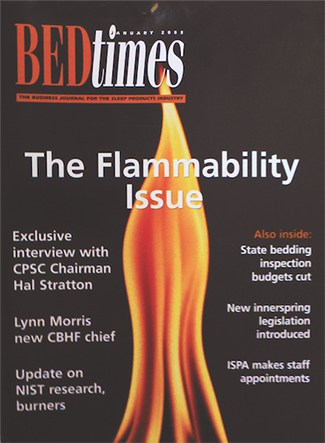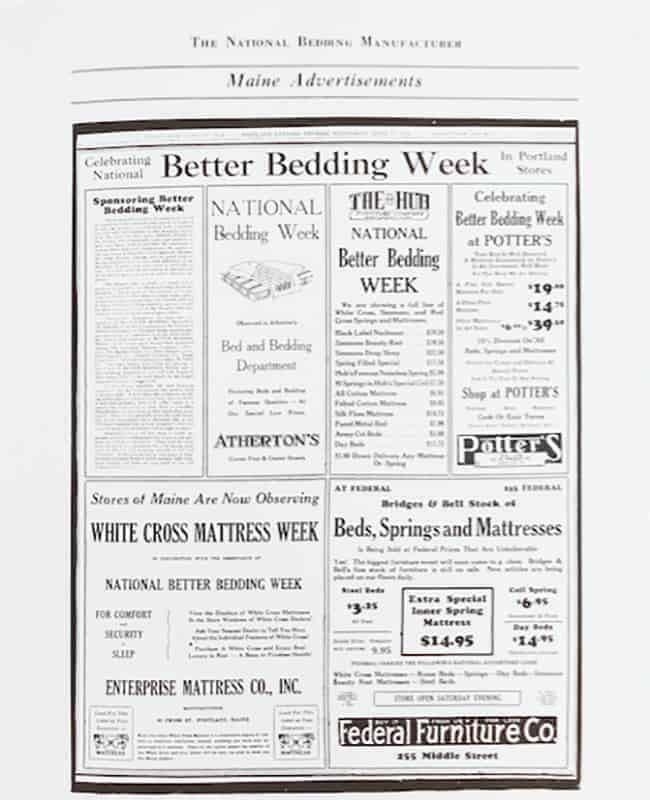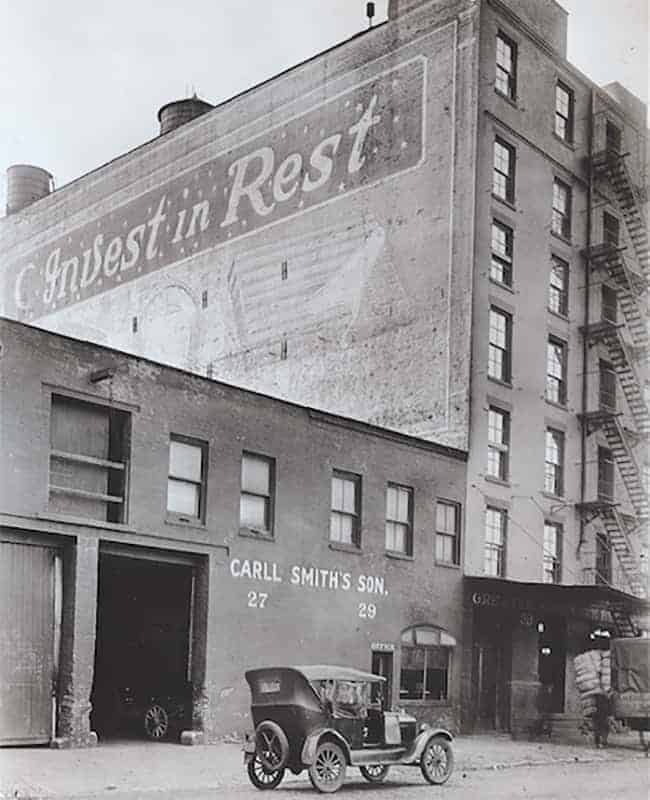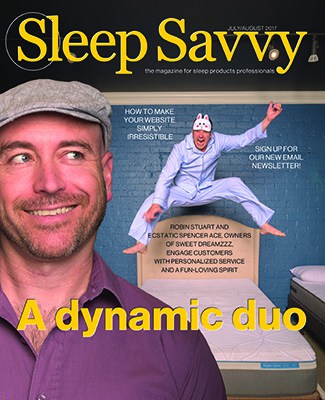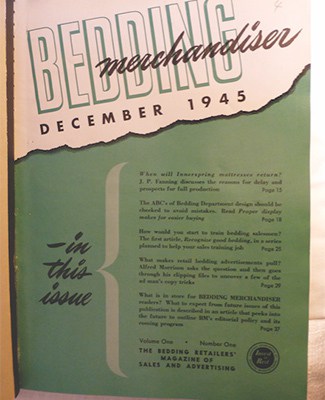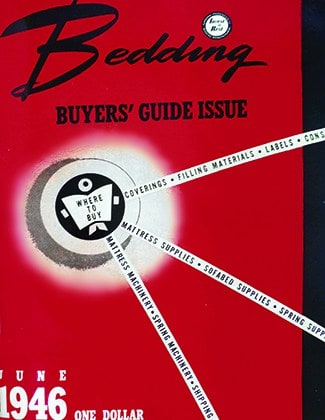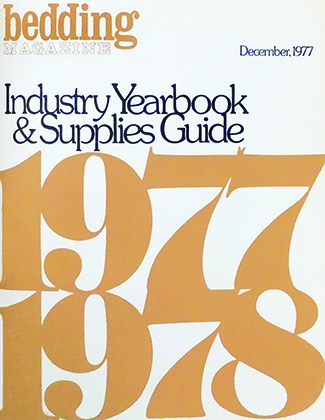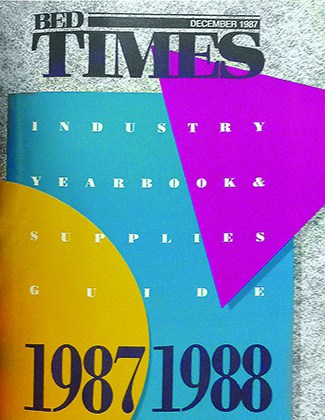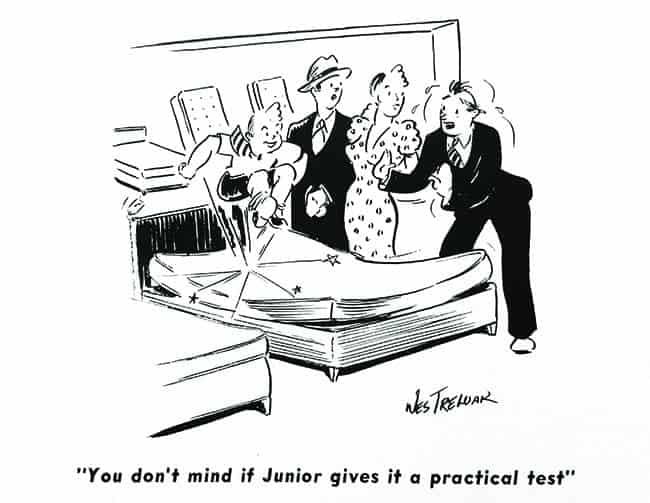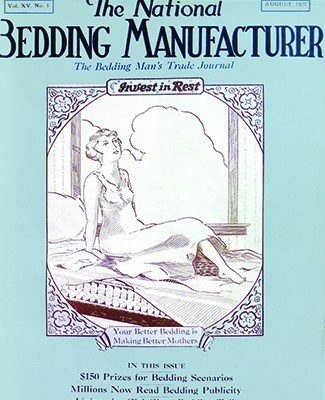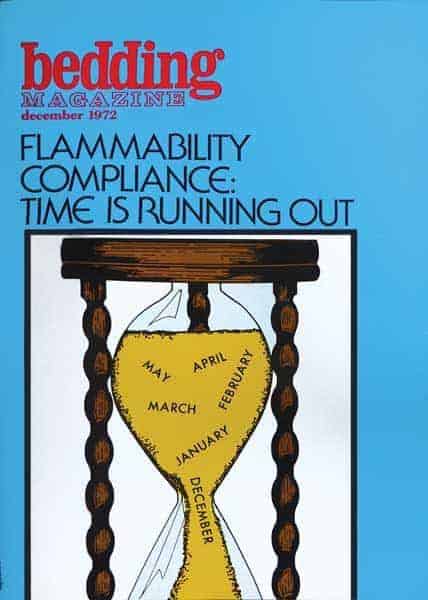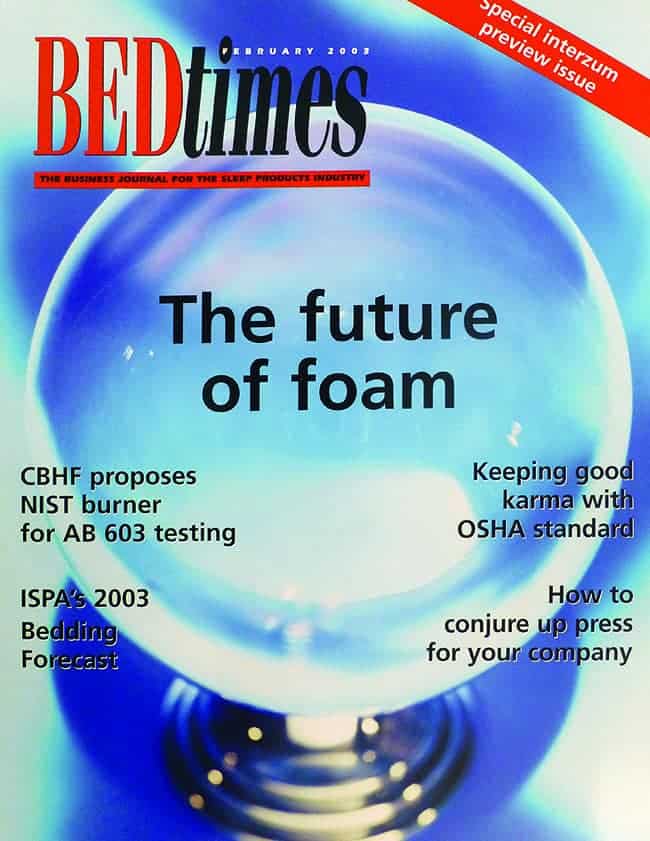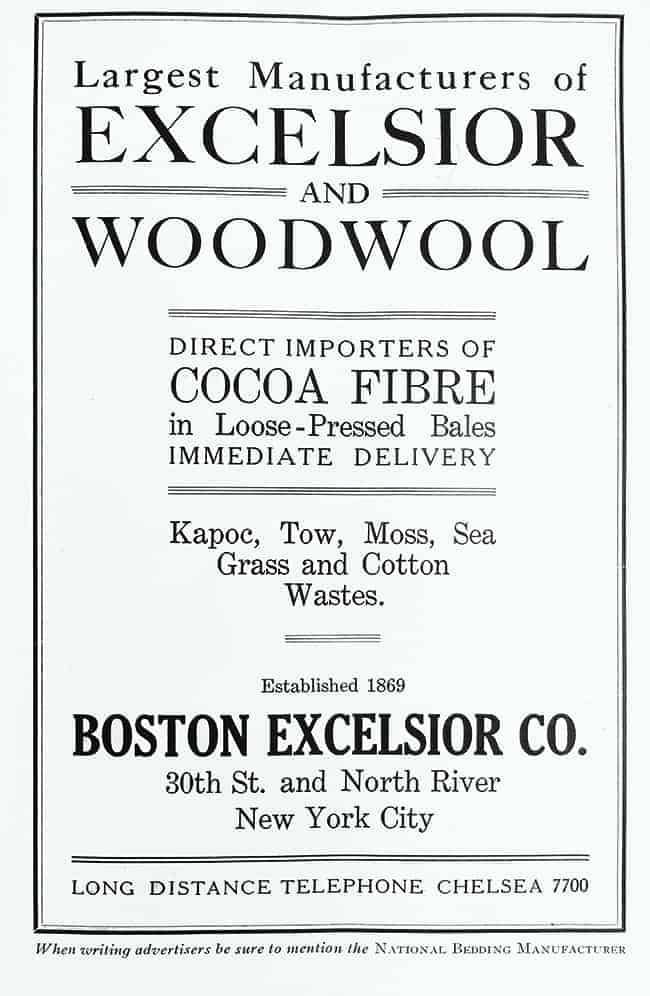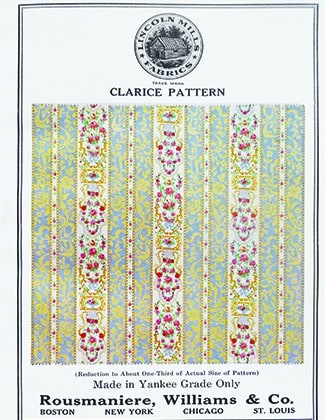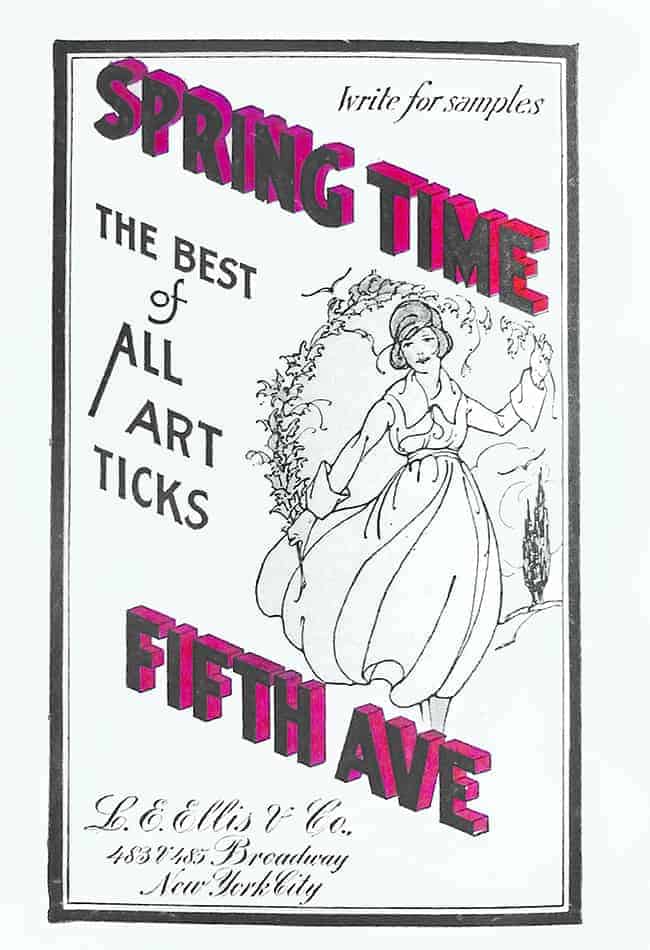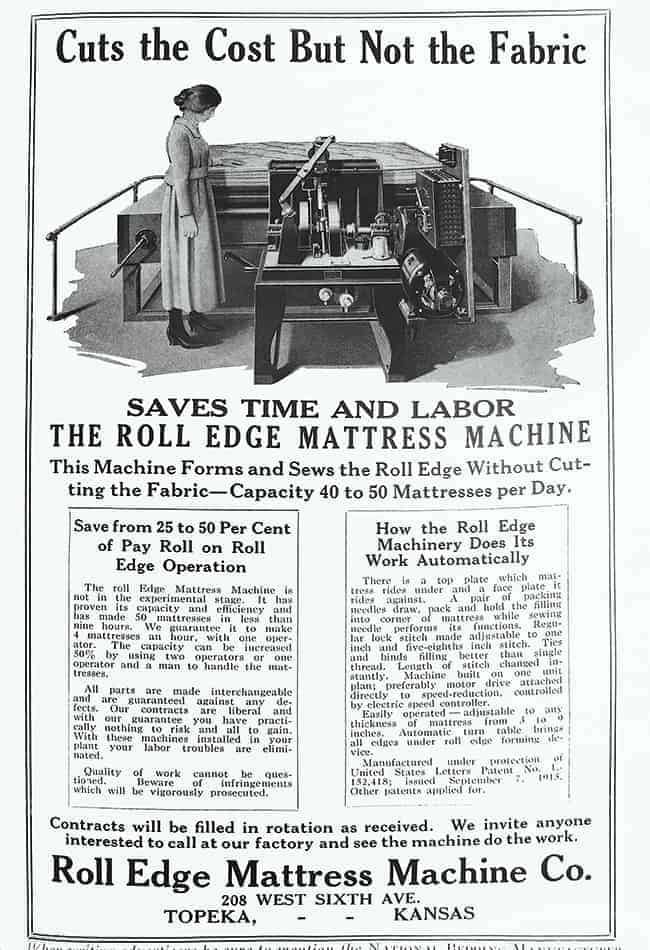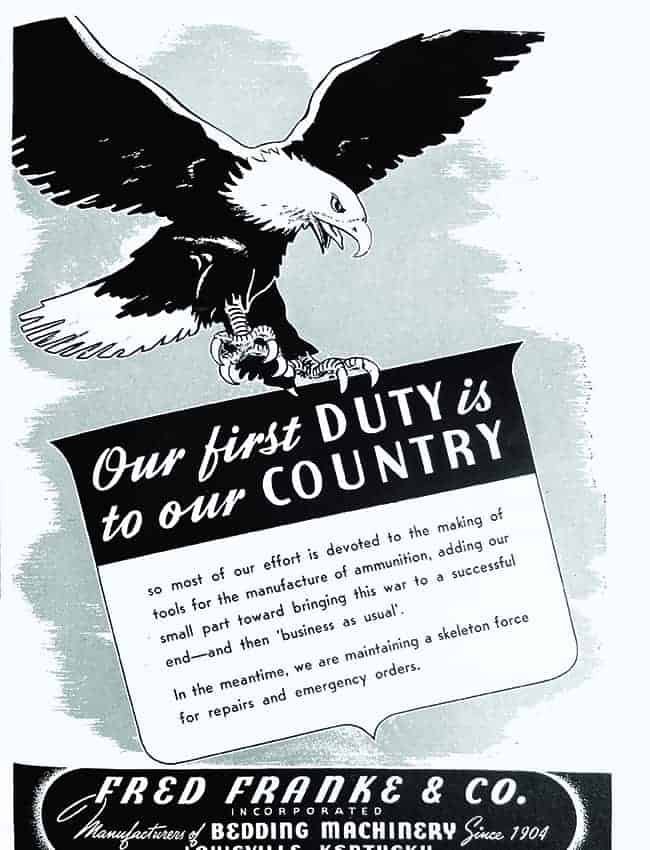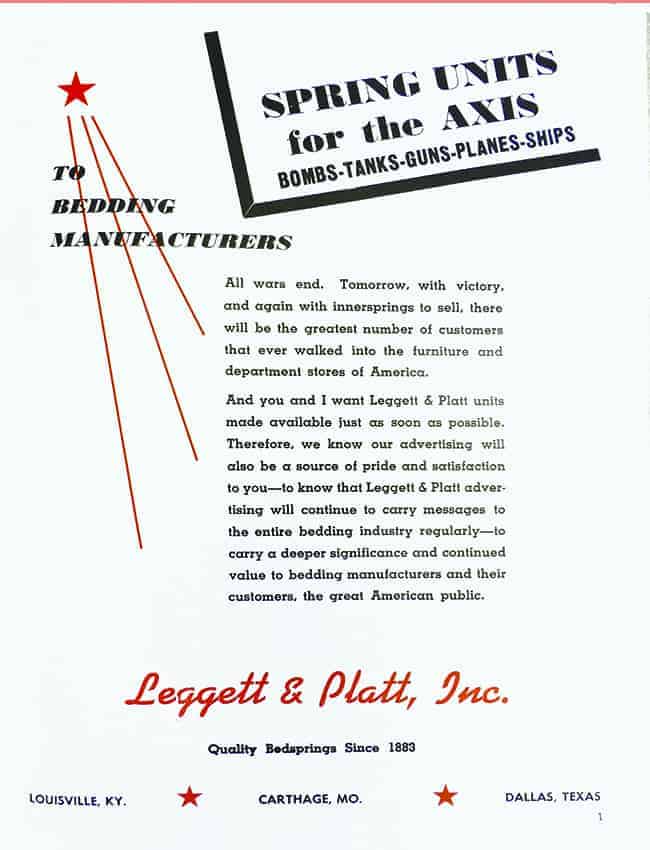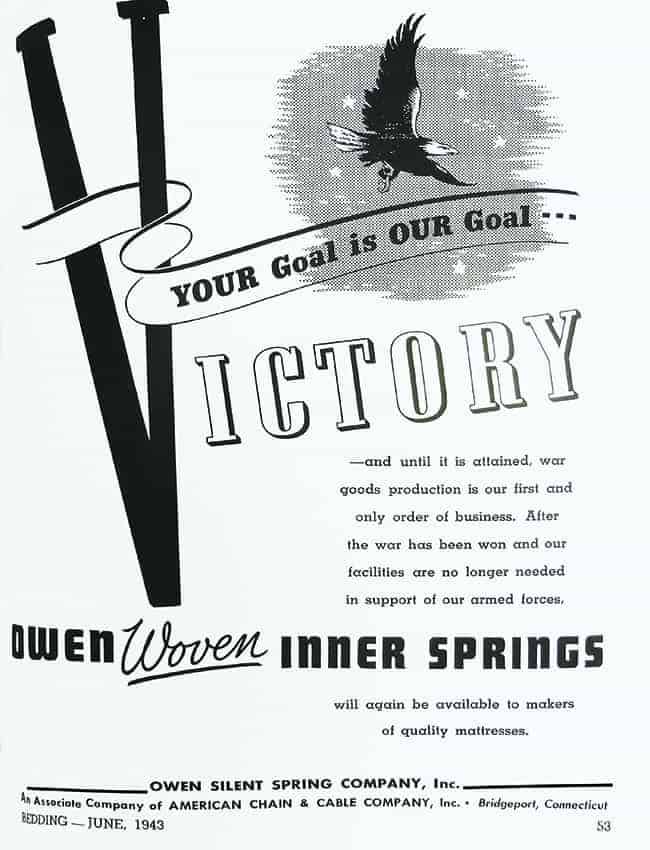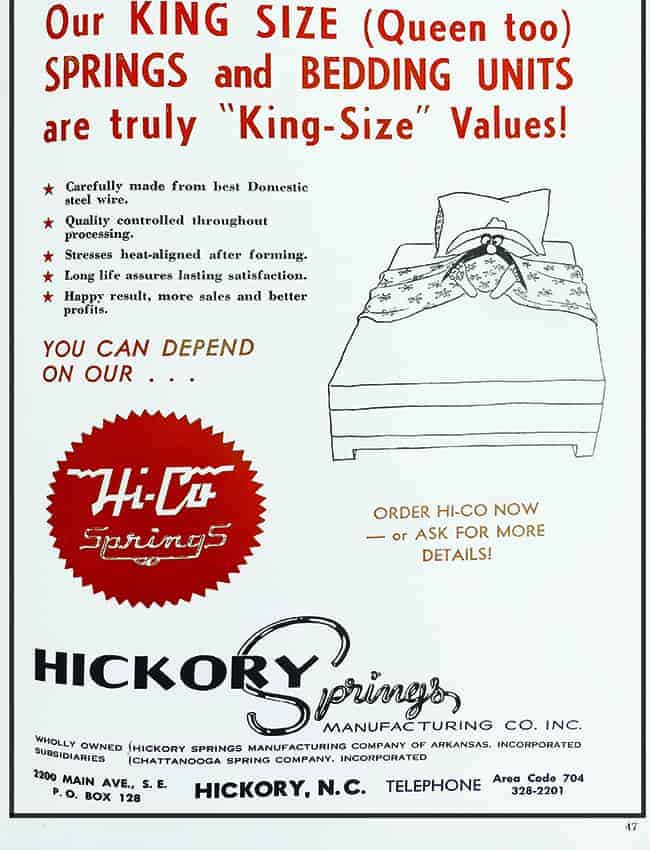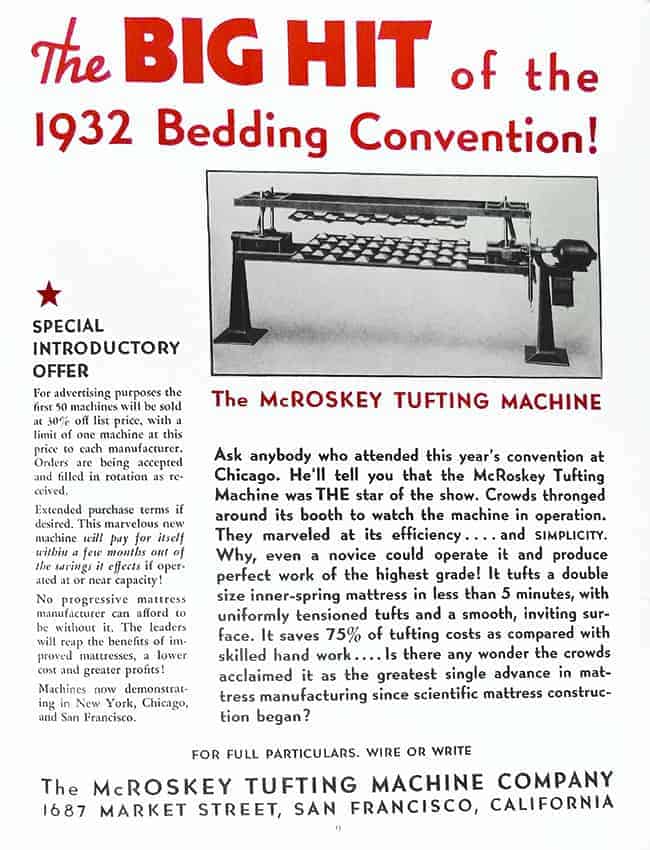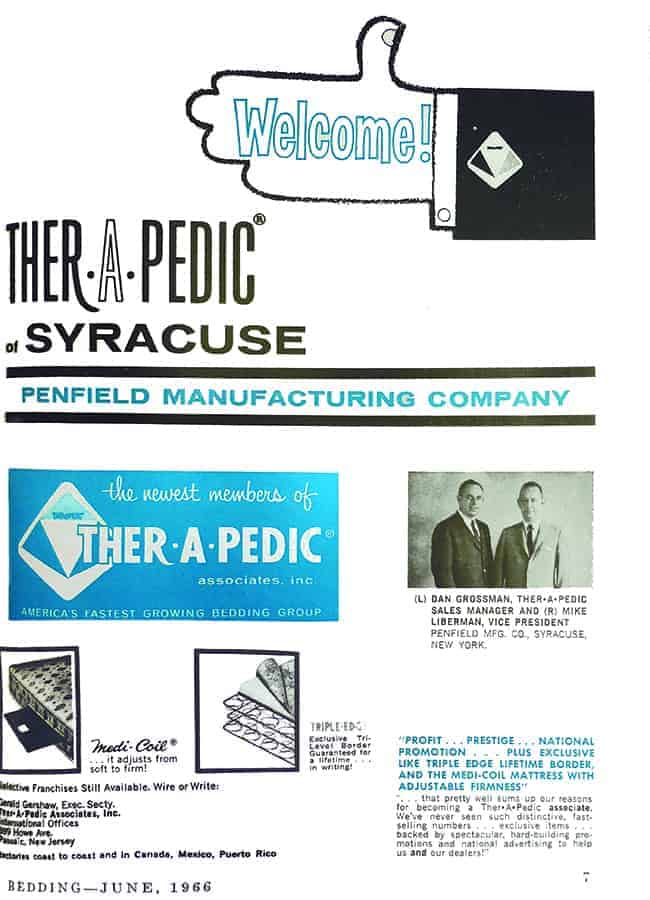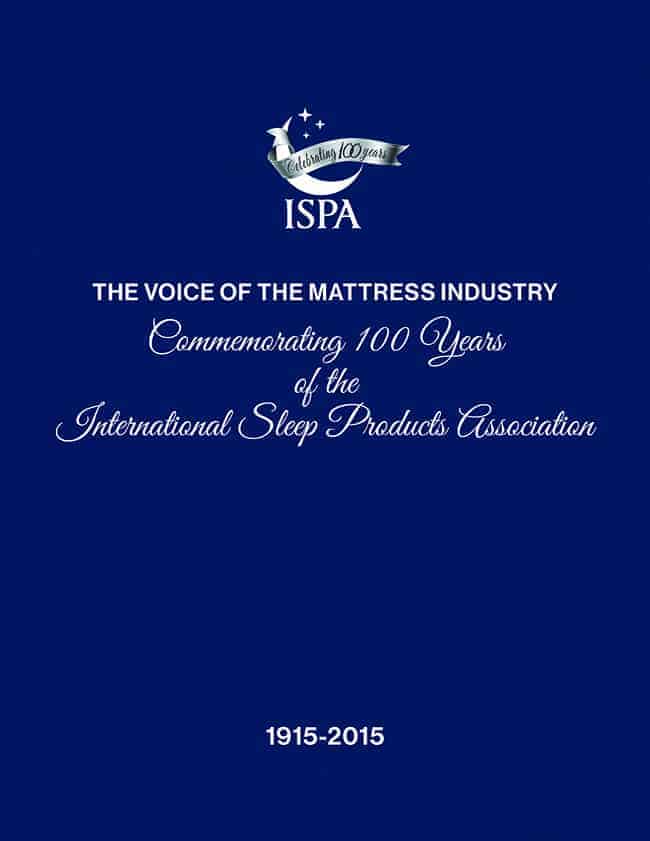BedTimes Magazine Celebrates 100th Anniversary
The business journal for the International Sleep Products Association marks its centennial this month. The following retrospective chronicles the publication’s past and offers insight into its present and future.
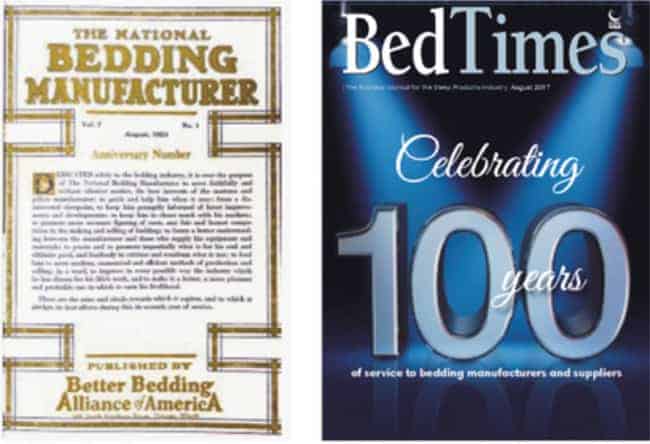
First and latest BedTimes’s very first issue in 1917 (left) and its current cover.
Without interruption, every month for 100 years, BedTimes has appeared on the desks of chief executive officers and in the breakrooms of factory floors.
It is the only magazine dedicated to mattress and sleep products manufacturing and, as such, has helped bedding producers shop for equipment, make plant and operations more efficient, pilot the regulatory environment, anticipate consumer trends and set business strategies.
It has done that 12 times a year for a century—that’s 1,200 regular issues in continuous publication. It is a remarkable achievement for any magazine. And, frankly, people outside the industry may be astounded to learn that there is, indeed, a magazine devoted to the production of mattresses, making its success even more impressive.
Of course, the publication didn’t start out as BedTimes—that name wouldn’t be adopted until 1987. The magazine began as The National Bedding Manufacturer, which debuted in August 1917, published by the fledgling National Association of Bedding Manufacturers, which itself would become the International Sleep Products Association, also in 1987.
Over the past century, the magazine—regardless of name—has helped the industry survive world wars and a Great Depression, not to mention sea changes in the regulatory landscape, business models and the bedding marketplace itself. In bad times, it has offered practical support and guidance; in good times, it has encouraged the industry to dream and set a course for greater achievement.
This month, BedTimes celebrates its 100th birthday, and we take this opportunity to trace our history, assess our contributions to the industry—and to celebrate a little.
A mattress industry star is born
Before we get to the birth of the magazine, we need to start with the conception of its parent. The basic framework for the mattress industry association we know today as ISPA was hammered out during a meeting of 39 manufacturers in Chicago on Dec. 8, 1915. About a year later—March 4, 1916—owners of nine other companies joined the original group and formally created the National Association of Mattress Manufacturers. The name was altered about a year later to the National Association of Bedding Manufacturers. (Name changes, you might have surmised, are a recurring theme in this story.)
The association’s original mission was not that different from ISPA’s today: to elevate the image of the mattress industry and its products, fight for members’ common interests and disseminate vital information to manufacturers, suppliers and others with an interest in mattress production and sales.
And that last part—disseminate vital information—is where the monthly magazine came in. NABM needed a way to tell its members about all the activities of the quickly growing organization and to rally support for a host of industrywide initiatives. It’s important to note here that the association was formed during a particularly volatile time. There were fears worldwide (well-founded, it turns out) that a war in Europe would spread and, closer to home, worries that an unruliness in the bedding industry also threatened widespread damage, if of a far different type. You see, back then there were no industrywide standards governing matters like mattress constructions or advertising, and unscrupulous companies were sullying the good names and livelihoods of more reputable producers.
A monthly magazine was a way to get the industry on the same page, so to speak. And less than 18 months after the association itself was established, it published the inaugural issue.
“The National Bedding Manufacturer now for the first time sees the light of day,” editor John D. Pierce wrote in a “birth announcement” headlined “Our New Baby.” “It is a healthy baby, well nourished with advertising, and if its face (cover) is not fair to look upon, you will have to blame its father.”
That humorous take aside, the first issue is earnest and, with all due respect to Pierce, a little dry. Its 36 pages were devoted to comprehensive coverage of that year’s bedding convention. And we mean comprehensive: In that issue and for decades to come, the magazine published page after page of minutes and full transcripts from convention meetings in tiny type. But other features—including an article explaining how to calculate overhead expenses and a “Want Ad. Department” where companies could advertise, at no cost, job openings or machinery and components for sale—made clear the magazine had a broad goal of helping its readers improve their businesses.
Pierce promised more to come in subsequent issues, including personnel news (“We all like to see our names in print, and the more we know about each other’s business joys and troubles, the better acquainted we become and the more confidence we establish.”) and “Letters from Members.”
Today, some people might be surprised by the existence of a 100-year-old bedding industry magazine, but its first editor was hopeful about such a future.
“We believe it has before it a long and useful life. We must try to make it truthful and to keep it clean, to give it high ideals and purpose in life, so that it may be a credit to us and make us a credit to the industry,” he wrote. Pierce may have been a middling humorist, but he was prescient.
‘The best commercial magazine’
The magazine was a quick hit. That inaugural issue went to 150 subscribers; by 1921, the circulation list had grown to 750.
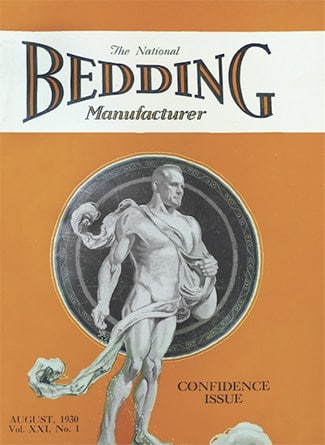
Even in the face of adversity, as during the Great Depression, the magazine encouraged manufacturers with its hopefulness.
Unlike many magazines published by trade groups then and now, The National Bedding Manufacturer has never been a “house organ.” Although it reports the activities of the association, it has a broader mission of covering the entire mattress industry and all its players. And, in its role as an industry magazine rather than exclusively an association magazine, it has relied on advertising revenue and subscription fees to sustain its operations.
Both advertising support and overall page counts (which are inextricably linked in periodicals publishing) grew quickly. The magazine counted 13 advertisers in its first issue; by the fourth anniversary issue in August 1921, the magazine proudly boasted of 50 pages of ads among its 96 pages. By the late 1920s when the economy was booming, total page counts reached 176.
The cost of an annual subscription grew far more slowly, a trend likely welcomed by readers. At the start, a full year of the magazine cost $1.50 and was bumped up in 1920 to $2, with individual copies sold for $0.25. Rates bounced around but generally were a buck or two annually for decades. Today, the print edition of BedTimes is free to mattress manufacturers worldwide. ISPA member companies qualify for free subscriptions for all employees. Nonmember mattress manufacturers qualify for one free subscription per facility. Paid subscriptions are available for nonmembers, as well as for companies and individuals not related to the bedding industry. To learn more, visit BedTimesMagazine.com.
The publication was self-sustaining nearly from the start. In 1918, the association posted $8,852 in income from The National Bedding Manufacturer (and only $2,259 in expenses), compared with $12,245 in income from “dues and pro rates,” NABM’s other large source of income at the time.
“The magazine has been a great financial help to the Association and the Auditor’s report shows that again this year the profits from the magazine have been sufficient to pay your Business Manager’s salary,” writes Pierce in a report to association leaders that appeared in the January 1920 issue the magazine. “You have doubtless noted the increase in advertising pages. The circulation has also increased in Canada, France, Holland, Australia, and even in New Zealand.” Yes, from its start the magazine had readers around the world—and they were engaged.
An early advertiser wrote: “We thought you would be interested to know that today’s mail brought an inquiry from Brisbane, Australia, which is the second we have had from Australia in direct answer to our advertisement in the Association magazine.”
Readers, too, wrote in to share their praise: “We believe The National Bedding Manufacturer has been the greatest help to us of any publication that has fallen into our hands in the 27 years we have been in the bedding business,” one bedding maker told the editors. Another said, “I believe The National Bedding Manufacturer is the best commercial magazine published by any organization, and we take dozens of them.”
Pragmatic optimism in tough times
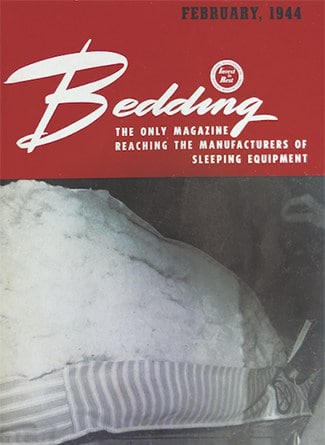
In February 1944, the magazine shortened its name to simply Bedding.
When NABM still was in its infancy and striving to bring together hundreds of individual manufacturers to better the industry and expand the market for all, the magazine, too, focused on the idea of cooperation. Its pages were filled with articles tackling key issues like truth-in-advertising campaigns and the creation of state bedding laws to protect consumers from unsanitary bedding. Taking seriously its task to call out and shame wrongdoing, The National Bedding Manufacturer often read like a police blotter.
A not uncommon story that ran a full page started, “The following bedding manufacturers were convicted of violating the New York State Bedding Law during the month of May.”
Paging through the archives, it’s striking to see how the magazine has helped shepherd the industry through its toughest eras. Two periods, in particular, are illustrative: the Great Depression and World War II. Both show an inherent hopefulness in the publication—not a Pollyannaish view of circumstances but a pragmatic optimism: We are in this together. We are strong. We are capable. Or, to put it more succinctly: We got this.
In August 1930, the magazine published a “Confidence Issue” in which both articles and advertisements sought to buoy the spirits of an industry being dragged down by the economic collapse around it. “An industry, dealing in such an indispensable necessity as sleep, is destined to go ever forward. We are looking ahead … we believe in this business,” proclaimed Adam Wuest Inc. in its ad.
The editors themselves wrote: “Business recently descended into a valley. The descent was vivid by contrast with the peak of a year ago. But, just as that peak was preceded by a valley, so we know that another peak will rise from the present valley. … Pessimism breeds pessimism. … As soon as we shake off that depressed mental attitude, business will be good again. … Spread the thought among your dealers. If your business is good, talk about it. … Do your share in restoring confidence.” The editors knew the industry was hurting, but also knew, painful as it was, the period would pass and manufacturers should be ready for an upturn.
The magazine—which had shortened its name in September 1930, dropping the “National” to become The Bedding Manufacturer—met the challenges of World War II similarly. (And interestingly, the war years brought another name change. In February 1944, the magazine’s moniker got even shorter still: simply Bedding.)
Before the war had even reached U.S. shores, the magazine published in its December 1941 issue (prepared and printed before the Pearl Harbor attack), “Emergency Action: The Industry Responds,” an article detailing how the association and industry were coping with the threat. It included updates about the industry’s already formed National Emergency Committee and the opening of an association office in Washington, D.C.—all in anticipation of government action like price controls and other edicts that could eventually impact bedding make.

During World War II, the magazine kept readers up to date on industry war efforts with notices like this one from January 194
In the January 1942 issue, in an article headlined, “War!”, the association praised the industry for efforts it had taken in advance to ready for a war economy and laid out steps manufacturers could take to handle a tricky triumvirate of requirements: supporting the war effort, coping with government restrictions and keeping their businesses profitable. The article said: “Each one of us has a grave responsibility. … It is up to you to do your part.”
And for the nearly four years that followed, the magazine’s pages are a mix of patriotism (lists of industry members called into military service, contributors to the National Emergency Fund, etc.) and practical information (updates on price controls, coming raw material restrictions, etc.). An April 1943 ad from United Button Tufters managed to elegantly combine patriotism with wartime practicality, telling manufacturers it was their “patriotic duty to keep all your equipment running at top efficiency.”
- The Bedding Manufacturer helped the industry ready for a return to peacetime production.
- During World War II, the magazine kept readers up to date on industry war efforts with notices like this one from January 1942.
Ever hopeful, The Bedding Manufacturer published in June 1943 its “Post-War Planning Issue” with articles like “What Will People Want in Postwar Sleeping Equipment?” and, until the war ended in 1945, looked ahead to opportunities awaiting bedding makers when service members returned home and restrictions were lifted on production.
The magazine would use the model set in those early decades to deal with other major challenges, for instance in the 1970s and 2000s, when the industry was consumed by federal cigarette and then open-flame flammability standards. And again, the magazine was the source for the latest news on the topic, as well as a resource for advice and guidance—and a place for advertisers to tell manufacturers about innovations that would solve their problems.
- The Bedding Manufacturer helped the industry ready for a return to
- peacetime production.
In more stable periods, both the industry and magazine have used the “downtime” to explain, promote and bolster enthusiasm for industry-bettering initiatives like “Invest in Rest” (the industry’s first PR campaign) and National Better Bedding Week, both launched in the 1920s. In the early 1960s, the magazine focused on the industry’s “Supersize” and Measure Your Mattress Month’s efforts to get consumers to buy queen- and king-size beds. In the 1970s, the push was for the launch of the Better Sleep Council, with its initial “Sleep Better, Live Better!” slogan and plans for national public relations campaigns to build consumer awareness about the link between a quality mattress, sleep and wellness. Most recently, the magazine has focused on industry efforts to improve mattress recycling and the creation of the new industry organization the Mattress Recycling Council.
- The magazine aided mattress makers and suppliers as they prepared for flammability
- standards—first the cigarette standard in the 1970s and then the open-flame standards in the early 2000s.
- The magazine aided mattress makers and suppliers as they prepared for flammability
Staying on the bedding trend
In terms of design and editorial content, the publication has evolved not only along with the bedding industry, but also along with the publishing industry.
In its earliest years, The National Bedding Manufacturer was dense with tiny type and long columns of text. But even then a few photos and illustrations—occasionally even limericks, poems and jokes—lightened things up. Pops of color—on the magazine’s cover and in the advertisements of companies willing to pay the extra cost for such an attention-getter—also livened things up. Since its launch, the magazine has gotten regular makeovers, with fresh layouts, design elements, typefaces and paper stocks (sometimes tissue thin and matte; sometimes smooth and glossy like today).
- The industry created Better Bedding Week in 1929 and applauded retail partners who advertised it.
- Efforts to get consumers to buy bigger beds often made the cover.
- standards—first the cigarette standard in the 1970s and then the open-flame standards in the early 2000s.
By the 1950s, the magazine had adopted the hallmarks of a modern editorial structure that remain today: a mix of fresh cover and feature stories in each issue, combined with regular departments. By then, the publication also had expanded its two-person team beyond an editor in chief and managing, associate or assistant editor to include production and circulation managers—although those staffers typically held dual roles at the association itself well into the 2000s.
The publication’s last redesign in July 2011 created the look BedTimes has today. The editors are excited to announce a new design will be unveiled in 2018. (Every magazine should start its second century with a fresh appearance!)
By 1976, the magazine’s annual revenue had grown to $235,000 and its monthly readership was nearly 3,000, but a reader survey taken during that time confirmed what editors had long suspected. Each issue of the magazine was circulated throughout manufacturers’ offices and factory floors, meaning as many as 7,000 or 8,000 people actually were reading it every month. That wasn’t a surprise given the high marks subscribers gave the magazine in that same survey, saying it was a “high-quality” publication that kept them “well-informed” and “up to date.”
A decade later, the magazine—and association itself—would undergo significant changes when, in March 1987, NABM rebranded itself as the International Sleep Products Association and moved its headquarters from Washington, D.C., to nearby Alexandria, Virginia. The magazine, too, got a whole new name—BedTimes—and, of course, a new look.
“BedTimes has a contemporary ring, is upbeat,” the editors wrote. “As we move into the latter part of the Eighties with a renamed, redesigned, rededicated magazine, we hope that you’ll look to BedTimes as the industry publication that’s a must-read for you and your colleagues.”

Website: At BedTimesMagazine.com, subscribe to the magazine’s e-newsletter and view current and past issues.
As accurate as Pierce, the magazine’s first editor, was in predicting the magazine’s long tenure, we’re pretty certain he couldn’t have envisioned some of the changes to his “baby” that took place in the late 1990s and into 2000s as BedTimes evolved from being a print-only publication to a multimedia enterprise.
The magazine first went online in 1997, with webpages on ISPA’s main website. It now has its own digital home at BedTimesMagazine.com, where readers can catch up on the latest industry news, read the complete current issue (particularly helpful for international readers who sometimes receive print editions later), read archived issues, get advertising and subscription information, and more.
Around 2010, the magazine got social, with accounts on Facebook, LinkedIn, Pinterest, Twitter and YouTube. When the next huge social media app for business comes along, you’ll find us there, too. And just this spring, BedTimes debuted BedTimes in Brief, an e-newsletter (click the top left to subscribe) delivered to readers’ email inboxes twice a month. At a time when many publications are closing or have been diminished by budget cuts, BedTimes is proud that both its print and digital products are healthy and thriving. And we are thankful for the continued support of our advertisers and readers.
Old is new—and true again
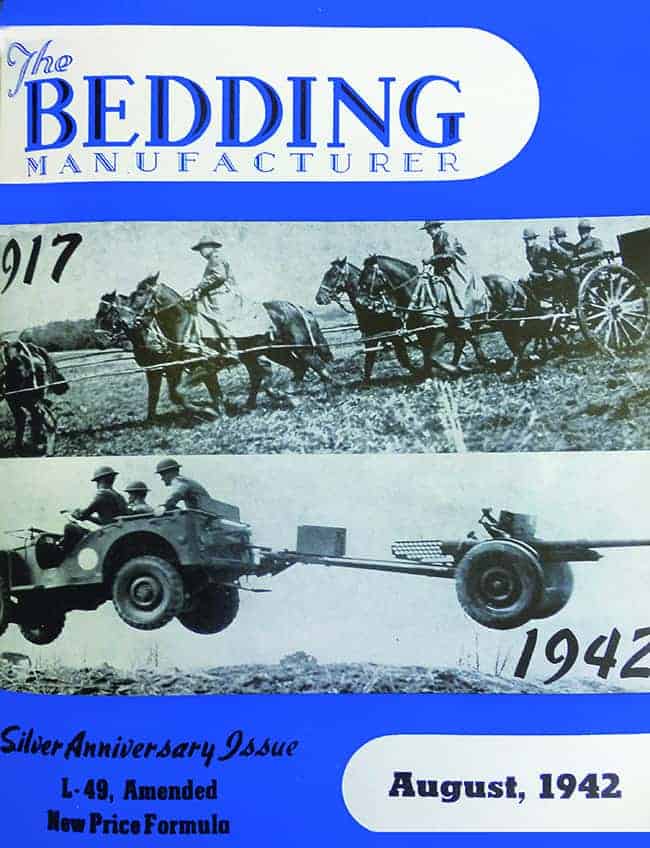
The magazine celebrated its 25th anniversary with a special cover, too, which illustrated the similarities in world events between 1917 and 1942.
We admit we have no idea what the next 100 years will bring to the bedding industry or BedTimes: Things change too rapidly these days.
But in pouring through the magazine’s archives, we found a statement we thought sums up well where BedTimes stands today—even though it was written in August 1942 in celebration of the magazine’s 25th anniversary. The editors noted then that most of the two dozen or so furniture trade journals around when The National Bedding Manufacturer debuted already were gone.
“Twenty-five years is a long time, especially in trade publications,” the editors wrote. “The Bedding Manufacturer is now an ‘old’ magazine. It has matured, but it has not grown mellow with the years. This issue demonstrates it to be tangier and zippier than ever.”
The BedTimes magazine mission
In August 1923, the magazine crystallized the mission that had been guiding it since its debut and went so far as to emblazon it on the cover, laying it out thusly:
“Dedicated solely to the bedding industry, it is ever the purpose of The National Bedding Manufacturer to serve faithfully and without ulterior motive, the best interests of the mattress and pillow manufacturer; to guide and help him when it may; from a disinterested viewpoint, to keep him promptly informed of latest improvements and developments; to keep him in closer touch with his markets; to promote more accurate figuring of costs, and fair and honest competition in the making and selling of bedding; to foster a better understanding between the manufacturer and those who supply his equipment and materials; to praise and to promote impartiality what is for his real and ultimate good, and fearlessly to criticize and condemn what is not; to lead him to more modern, economical and efficient methods of production and selling; in a word, to improve in every possible way the industry which he has chosen for his life’s work, and to make it a better, a more pleasant and profitable one in which to earn his livelihood.
“These are the aims and ideals towards which it aspires, and to which it pledges its best efforts.”
Five years later, the editors maintained that the magazine’s mission hadn’t changed, but mercifully shortened it to: “The policy has always been to publish for the benefit of the industry such material as will aid its members to produce a better product at a more satisfactory return.”
Sister publication
BedTimes magazine often has printed the occasional article about in-store displays and other items of interest to bedding retailers, but retail has never been the magazine’s focus.
Recognizing as early as the 1940s that reaching mattress manufacturers and their suppliers was only part of the equation in terms of building up the bedding industry and boosting sales, the National Association of Bedding Manufacturers launched Bedding Merchandiser in December 1945 for department and full-line furniture stores—the primary dealers of beds at the time.
Its pages were filled with profiles of successful bedding departments and ideas for everything from advertising and retail sales promotions to sales training. It was well liked by readers and had a strong circulation but struggled to maintain advertising support and was shuttered in 1957.
- At BedTimesMagazine.com, subscribe to the magazine’s e-newsletter and view current and past issues.
- The magazine celebrated its 25th anniversary with a special cover, too, which illustrated the similarities in world events between 1917 and 1942.
- At BedTimesMagazine.com, subscribe to the magazine’s e-newsletter and view current and past issues.
Several decades later, the association decided a retailer-focused magazine had, indeed, been one of the best ways to engage retailers and improve the consumer experience, and created Sleep Savvy for mattress sellers, including furniture and department stores, sleep shop chains, catalogs/online vendors and independent sleep shops.
Since its first March/April issue in 2002, Sleep Savvy, which is now published eight times a year, has been the only publication dedicated exclusively to educating retailers of mattresses and sleep products. With its engaging editorial voice, how-to focus and colorful design, it’s built a passionate readership in the United States and Canada. In 2005, it launched a website, SleepSavvyMagazine.com, and digital editions of the publication followed in 2009. And just last month, it debuted its own e-newsletter, Shop Talk by Sleep Savvy, which is emailed to readers twice a month. Not bad for a younger sister!
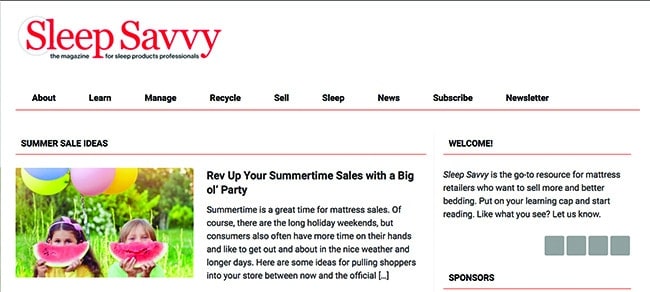
Website: Like BedTimes, Sleep Savvy has a robust website and a recently launched e-newsletter, Shop Talk.
When your magazine goes missing
Sadly, the launch of The National Bedding Manufacturer in August 1917 wasn’t entirely smooth.
As editor John D. Pierce explains in the second issue dated September 1917, “Several members reported that they did not get the August number of The National Bedding Manufacturer. As your editor was, in this case, the office boy who addressed the envelopes, he feels sure the copies got as far as the post office, at least.”
Today, BedTimes is mailed so that it hits U.S. readers’ mailboxes during the first week of the month, though because of varying postal systems and customs procedures worldwide, copies sent abroad often arrive weeks later than that.
And sadly, as much as BedTimes would like, circulation problems have not been entirely relegated to the past. Occasionally—because of a postal snafu or other glitch—a subscriber doesn’t receive a copy. If you have a question about your subscription, contact Mary Rulli, BedTimes circulation manager, at [email protected] or 336-491-0443.
Like Pierce 100 years before her, Rulli’s goal is to make sure you never miss an issue. But unlike Pierce, BedTimes offers people another way to read the publication at BedTimesMagazine.com. The latest issue is posted at the start of each month, allowing you to read complete articles, peruse ads and search for specific information from anywhere.
Simply click on the image of the cover in the righthand corner of the home page to flip through the entire digital edition.

In addition to the print edition, BedTimes also can be read online at BedTimesMagazine.com.
Taglines through time
If you’ve been a regular reader of BedTimes, you might not even notice it anymore, but on the cover of every issue, just below the magazine’s name (or “masthead” if you want to get all technical about it) is a tagline: “The Business Journal for the Sleep Products Industry.”
In the magazine world, it’s also called a “selling line,” but you can think of it as a mission statement or even a slogan. It explains what the magazine sets out to do—how it sees itself in the world.
The National Bedding Manufacturer debuted without a tagline and didn’t adopt one until it declared itself “The Bedding Man’s Trade Journal” a few years later. Since then it’s had a handful, reflecting changes to the industry and the magazine’s focus.
In February 1944, when the publication shortened its name to Bedding, it adopted an incommensurately lengthy tagline: “The Only Magazine Reaching the Manufacturers of Sleeping Equipment.” And in February 1958, when the magazine extensively covered sleeper sofas and similar products, the editors chose “Exclusively Devoted to Manufacturers of Bedding and Dual Purpose Sleeping Equipment.”
Magazine trends cycle like any others. At times the tagline has disappeared completely from the cover, as happened during a period in the 1960s, only to return again. The current tagline was adopted in September 1989. Now that you know the story behind it, we bet it will catch your attention.

From left: The taglines have evolved to reflect subtle changes in the industry’s focus. They’ve included ‘The Only Magazine Reaching Manufacturers of Sleeping Equipment,’ ‘Exclusively Devoted to Manufacturers of Bedding and Dual Purpose Sleeping Equipment’ and ‘The Business Journal for the Sleep Products Industry.’
Get your own copy of BedTimes
Fun fact: The first subscription card—a pre-addressed, postage-paid card that people could use to sign up for their own subscription to the industry magazine—first appeared in the publication in January 1974.
Today, there’s an even easier way to subscribe. If you’re reading a colleague’s copy of BedTimes and would like your own—or are a manager who thinks your whole team would benefit from reading the magazine each month—it’s easy to sign up for monthly subscriptions by going to BedTimesMagazine.com and clicking on the “Subscribe” button at the top of the home page. There you’ll also find links to update your address; sign up for BedTimes in Brief, the magazine’s new e-newsletter; and subscribe to sister publication, Sleep Savvy.
The print edition of BedTimes is free to mattress manufacturers worldwide. Member companies of the International Sleep Products Association qualify for free subscriptions for all employees. Nonmember mattress manufacturers qualify for one free subscription per facility. And, of course, you can read the complete current issue, as well as past issues, online at BedTimesMagazine.com.
A marketplace in print: Guiding manufacturers to the right products
Since its earliest days, the industry’s magazine has functioned as something of a marketplace—a trade show on the page, if you will. And we’re not just talking in terms of running advertisements from suppliers.
In August 1921, just four years after it began publishing, The National Bedding Manufacturer introduced a Directory of Supply Houses—a list of suppliers of components, machinery and services for mattress manufacturers with companies organized by category. (At the time, things like “cotton linters” and “curled hair” were big.) The first directory included only company names and street addresses, but it was a start—an easily accessible, well-organized place for bedding producers to find suppliers so they could start making calls, or at that time, start writing letters to learn more.
- What the bedding industry now knows as the BedTimes Supplies Guide began as a more humble Directory of Supply Houses in 1921. After disappearing for a time, the concept of a comprehensive directory of suppliers re-emerged in 1944 as the Buyers’ Guide. In 1946, it got a nifty, glossy cover to help make it last longer as manufacturers turned to it again and again throughout the year for machinery, equipment and components.
- What the bedding industry now knows as the BedTimes Supplies Guide began as a more humble Directory of Supply Houses in 1921. After disappearing for a time, the concept of a comprehensive directory of suppliers re-emerged in 1944 as the Buyers’ Guide. In 1946, it got a nifty, glossy cover to help make it last longer as manufacturers turned to it again and again throughout the year for machinery, equipment and components.
- Equipment,’ ‘Exclusively Devoted to Manufacturers of Bedding and Dual Purpose Sleeping Equipment’ and ‘The Business Journal for the Sleep Products Industry.’
The directory was discontinued during the Great Depression but revived in June 1944, when the magazine, then called Bedding, launched its Buyers’ Guide—a notable expansion of that earlier directory with more than “three thousand supplier sources” of everything from air compressors and anglers to wrapping twines and yarns.
The Buyers’ Guide expanded significantly again in 1949, published ostensibly as a 13th edition of the magazine but in spiral-bound format. In addition to a list of suppliers by product category, the improved guide included both an alphabetical and geographical listing of all suppliers, plus a “catalog style” directory with more extensive product descriptions and pricing.
The guide continued to evolve every few years, with new names, features and production schedules until it settled in the late 1990s as the BedTimes Supplies Guide, published annually as part of the December issue of the magazine as it still is today.
- What the bedding industry now knows as the BedTimes Supplies Guide began as a more humble Directory of Supply Houses in 1921. After disappearing for a time, the concept of a comprehensive directory of suppliers re-emerged in 1944 as the Buyers’ Guide. In 1946, it got a nifty, glossy cover to help make it last longer as manufacturers turned to it again and again throughout the year for machinery, equipment and components.
- What the bedding industry now knows as the BedTimes Supplies Guide began as a more humble Directory of Supply Houses in 1921. After disappearing for a time, the concept of a comprehensive directory of suppliers re-emerged in 1944 as the Buyers’ Guide. In 1946, it got a nifty, glossy cover to help make it last longer as manufacturers turned to it again and again throughout the year for machinery, equipment and components.
- What the bedding industry now knows as the BedTimes Supplies Guide began as a more humble Directory of Supply Houses in 1921. After disappearing for a time, the concept of a comprehensive directory of suppliers re-emerged in 1944 as the Buyers’ Guide. In 1946, it got a nifty, glossy cover to help make it last longer as manufacturers turned to it again and again throughout the year for machinery, equipment and components.
When relaunching the directory in 1944, the editors wrote, “Future annual issues of the Buyers’ Guide will, we hope, grow in scope to a point where it will (include) the minutest detail, so far as sources of supply for sleeping equipment manufacturers are concerned.”
And, in many ways, it did. Today, the BedTimes Supplies Guide is the most comprehensive directory of suppliers of machinery, equipment, components and services to the sleep products industry. In addition to the annual print directory, a digital version is available online at BedTimesSuppliesGuide.com.
And it just so happens, it’s time for suppliers to start thinking about updating and upgrading their online/print listings plus advertising in the December issue.
- What the bedding industry now knows as the BedTimes Supplies Guide began as a more humble Directory of Supply Houses in 1921. After disappearing for a time, the concept of a comprehensive directory of suppliers re-emerged in 1944 as the Buyers’ Guide. In 1946, it got a nifty, glossy cover to help make it last longer as manufacturers turned to it again and again throughout the year for machinery, equipment and components.
- What the bedding industry now knows as the BedTimes Supplies Guide began as a more humble Directory of Supply Houses in 1921. After disappearing for a time, the concept of a comprehensive directory of suppliers re-emerged in 1944 as the Buyers’ Guide. In 1946, it got a nifty, glossy cover to help make it last longer as manufacturers turned to it again and again throughout the year for machinery, equipment and components.
A few good laughs: Cartoons add levity to early issues
Cartoons not only lightened the mood, they lightened the page. Early issues of The National Bedding Manufacturer could be dense with type, and cartoons, photos and other illustrations added visual interest to otherwise dense pages.
- The Buyers’ Guide morphed into the Industry Yearbook & Supplies Guide, but its mission has remained the same—to be a comprehensive, useful directory for mattress makers.
- The Buyers’ Guide morphed into the Industry Yearbook & Supplies Guide, but its mission has remained the same—to be a comprehensive, useful directory for mattress makers.
- The Buyers’ Guide morphed into the Industry Yearbook & Supplies Guide, but its mission has remained the same—to be a comprehensive, useful directory for mattress makers.
The benefits of—and sometimes potential concerns about—industry products were frequent fodder for the magazine’s cartoonists.
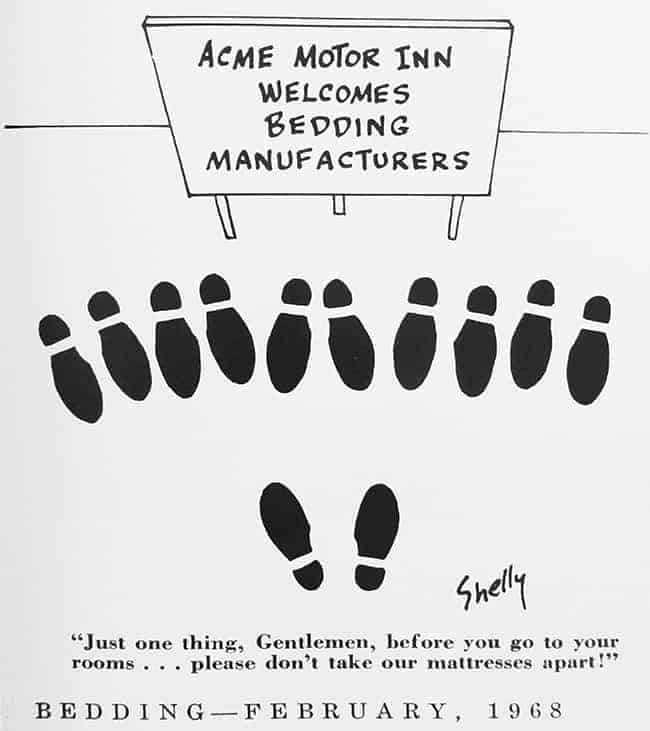
Ha! Change just a few words and this cartoon could run in the pages of BedTimes today.
Magazine makes a first impression
You may not be able to judge a book by its cover, but you can tell a lot about the evolution of the bedding industry’s magazine—and the industry itself—by looking at the publication’s covers over the past 100 years.
- When the magazine commissioned its first illustrated cover in 1925, it was quite something: A detailed depiction of a bedding king.
- Early issues of The National Bedding Manufacturer didn’t include illustrations or photos on the covers. It would be easy to mistake this cover for a table of contents.
Glancing through them you see how the publishing industry and magazine design trends have evolved, but more importantly, you can see what issues, events and trends were top of mind for mattress makers, suppliers and even retailers over the past century.
You’d be forgiven if you mistook the inaugural cover of the magazine for the table of contents because it did double duty as that, listing all the main articles and their page numbers. Though attractive given the design trends and printing capabilities of the time, it doesn’t look like a magazine cover as we think of it today. There are no images, just text and a border design in blue and gold. But it gave readers all the information they needed: Magazine title, publishing organization’s name, volume and issue number, and a glimpse at what they would find inside.
- In 1927, the magazine started changing the image on the cover each month. An illustration by Norman Rockwell was a holiday treat in 1931. More than two years after the stock market crash, the industry still was wrestling with the depression, a frequent cover subject.
- In 1927, the magazine started changing the image on the cover each month. An illustration by Norman Rockwell was a holiday treat in 1931. More than two years after the stock market crash, the industry still was wrestling with the depression, a frequent cover subject.
- Ha! Change just a few words and this cartoon could run in the pages of BedTimes today.
Each month, the cover text changed, but not the overall design itself until August 1925, when the magazine unveiled its first image-oriented cover. And it was quite an image—a moody illustration of a king sitting on a throne atop the world, two female figures forming the rough outlines of the United States and Mexico on the globe below him. There’s a night sky in the background, and a banner above the king’s head proclaims The National Bedding Manufacturer to be “dedicated to the sovereigns of sleep who rule the rest of the world.” It is something to behold and, in fact, readers beheld it for a few years—it repeated monthly, changing only in terms of its coloration.
In August 1927, the magazine removed the king of sleep from his throne and ushered in a more modern era of design, with a new front-facing photo or illustration each month. In 1931, the editors surprised readers with a holiday present: an illustration on the December cover by famed artist Norman Rockwell of Santa inspecting a globe in search of “good boys” deserving of gifts.
- When the magazine commissioned its first illustrated cover in 1925, it was quite something: A detailed depiction of a bedding king.
- Early issues of The National Bedding Manufacturer didn’t include illustrations or photos on the covers. It would be easy to mistake this cover for a table of contents.
- In 1927, the magazine started changing the image on the cover each month. An illustration by Norman Rockwell was a holiday treat in 1931. More than two years after the stock market crash, the industry still was wrestling with the depression, a frequent cover subject.
The cover is, of course, the place for big news: a man facing a world bearing the weight of a single word—“Depression”—in March 1932; a waving flag rallying the industry to do its part for the war effort in July 1942—“United We Stand.” And when that war finally ended: an image of the Honorable Service Lapel Pin and these solemn words: “All men and women who are honorably discharged from the armed forces will wear this button. Remember, they have served America well. And so helped protect the things you love … your home, your family, your freedom. Join in saying to them, ‘Well done and welcome home.’ ”
In the 1970s and again in the 2000s, the industry was facing wholesale changes in how it produced mattresses because of new flammability regulations, and countless magazine covers were devoted to the latest FR news. Industry-changing trends—think advancements in foams, springs and boxed beds—all have been announced with big headlines. And this month, the cover lets you know the magazine has something big to celebrate: its 100th birthday.
- In 1927, the magazine started changing the image on the cover each month. An illustration by Norman Rockwell was a holiday treat in 1931. More than two years after the stock market crash, the industry still was wrestling with the depression, a frequent cover subject.
- In 1927, the magazine started changing the image on the cover each month. An illustration by Norman Rockwell was a holiday treat in 1931. More than two years after the stock market crash, the industry still was wrestling with the depression, a frequent cover subject.
Advertising through the ages
A baker’s dozen of mattress industry suppliers ran advertisements in the inaugural issue of The National Bedding Manufacturer, helping to support the publication financially and boosting their own businesses by putting themselves in front of readers who required the very products they offered.
Because the bedding industry magazine never was intended as a “house organ,” it always has relied on advertising (and to a lesser extent, circulation revenue) to be a self-sustaining publication. More than a decade after its debut, its 13 initial advertisers still were running ads in the pages of the magazine and had been joined by many others.
- For decades, important industry topics—from proposed industry
- initiatives to wars to
Throughout the magazine’s history, suppliers to the bedding industry have understood that the magazine’s readers are their customers. And as the only monthly magazine devoted to mattress manufacturing, BedTimes remains one of the most effective, targeted ways for companies to reach bedding producers.
But advertisers’ contributions to the publication go beyond the financial. In their effort to draw attention to their companies and offerings, many advertisers were the first to take advantage of new printing and publishing techniques, like full-color images, that would eventually spread to the editorial content, as well.
The earliest ads appearing in the magazine are simple and heavily reliant on text, typically just a handful of words about the company and its products, maybe with a single illustration or graphic to catch the eye. With telephones still in their infancy, ads listed no phone numbers, just street addresses.
But even in those first years, some advertisers were paying extra for single-hued, “spot color” ads to stand out from the competition. And it’s not surprising that a supplier of mattress fabrics, arguably the industry’s prettiest component, was the first to run a full-color image when in 1921, Titus Blatter & Co. showed off the vibrancy of a ribbon-effect ticking pattern. Fabric suppliers were, in fact, some of the biggest innovators in terms of advertising. In 1924, Rousmaniere, Williams & Co. ran a specially designed ad that encouraged readers to peek under a ticking pattern flap to learn more about the company and its products.

Fabric suppliers like Titus Blatter & Co. were among the first to embrace full-color images.
By the 1950s, full-color ads were common in the magazine, but it was during the 1960s when advertisers really began to experiment. In July 1964, Jones & Laughlin Steel Corp. outdid itself with a fancy ad insert that doubled as a 33 ¹/3 rpm record that readers could pull out and play on their own phonograph. It featured famed comedians Jonathan Winters, Mike Nichols and Elaine May in a routine they recorded to promote the industry’s Measure Your Mattress Month.
Others played around with attention-getting paper stocks and other treatments. For instance, in May 1965, Bechik Products Inc. ran a full-page ad printed on thick paper with embossed type mimicking a stitching pattern to promote its threads and bobbins for multineedle quilting machines. Polyken Industrial Tapes may have been the first advertiser to run an ad featuring an actual sample of its product when it placed its “bi-part” tape along the right edge of a full-page ad in 1967. Later, it would become more common for suppliers of nonwovens, FR materials, ticking and labels to tuck swatches of their products into the magazine to entice customers.
Machinery makers, with big products to display and sometimes bigger advertising budgets, too, were among the first companies to take out multipage ads or “spreads,” as Droll Patents Corp. did in 1923 when it bought a bright green spread to tout innovations like its Droll Mattress Beater.
We’d do a disservice to the founders of the publication who recognized the importance of advertising if we wrapped up this story without mentioning that if your company is interested in advertising in the BedTimes print edition, on its website or in its new e-newsletter, you can contact Kerri Bellias, ISPA vice president of sales, at [email protected] or 336-945-0265.
- For decades, important industry topics—from proposed industry
- initiatives to wars to
A glance at changing ad styles in the 20th century
- regulatory changes— have gotten the cover attention they deserve.
- For decades, important industry topics—from proposed industry
- initiatives to wars to
- regulatory changes— have gotten the cover attention they deserve.
- Two more recent covers spotlighted big product trends that have changed the industry—foam
- advancements and boxed beds.
- Two more recent covers spotlighted big product trends that have changed the industry—foam
- advancements and boxed beds.
ISPA’s centennial celebration
For a century, the International Sleep Products Association and its monthly magazine have been intrinsically linked and, in 2015, when ISPA celebrated its own centennial, BedTimes chronicled the rich history of the association and 100 years of the bedding industry in a four-part series of articles that later were compiled into a book, “ISPA—The Voice of the Mattress Industry: Commemorating 100 Years of the International Sleep Products Association.”
You can read the magazine series or view the entire book by searching “ISPA Centennial” at BedTimesMagazine.com.




